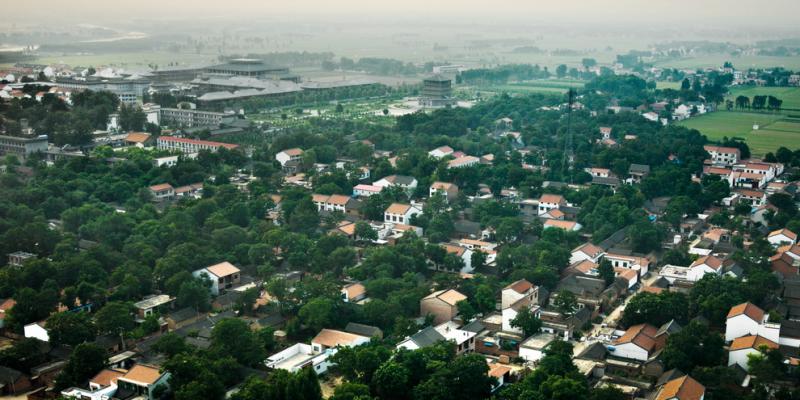
陈家沟村全貌
河南省温县陈家沟,位于温县城东六公里的清风岭中段。村南隔黄河相望有虎牢关、伏羲台、河洛汇流处等。距陈家沟西北不远处有道教圣地阳落山“二仙庙”,西南一百公里处有少林寺,道教文化、佛教文化与儒教文化都在这里汇集,形成了推动中华文明发展厚重的中原文化。
明朝初年,陈家沟陈氏始祖陈卜从山西移民到此,便带有家传武术。这里沟壑交错、兵匪出没,经常骚扰百姓,为了保卫桑梓,村里成立了武学社,陈家沟人习武成风。这里特殊的人文地理环境和厚重的中华传统文化对陈王廷创编太极拳产生了深远影响。
陈王廷(字奏庭,1600~1680),陈家沟陈氏第九代人,出生于明万历二十八年,明武庠生,清文庠生。其祖陈思贵,任陕西狄道县典史;其父陈抚民,曾任征士郎,均好拳习武。
陈王廷自幼勤奋好学,昼练武,夜习文,不但深得家学真传,出类拔萃,而且熟读诸子百家,学识渊博,文武兼备,精于拳械,功夫深厚,有超人的轻功绝技。年轻时走镖山东一带,扫荡群匪,匪寇闻“名”丧胆。晚年,陈王廷隐居乡里,以《黄庭经》为伴,潜心研究易学,收集整理民间武术。他理根太极,秉承中国传统的“天人合一”思想和阴阳生克之理,在家传拳术的基础上,将众家武术之长融汇合成,加上自己平生习武所悟,融中医经络学与道家导引吐纳术为一体,创编了一种刚柔相济、阴阳互化、变幻莫测、威力无比的武术拳种——“太极拳”。
陈王廷所传授下来的有五路拳、五路捶、108式长拳,双人推手和刀、枪、剑、棍、锏、双人粘枪等器械。其中双人推手和双人粘枪,更具有前所未有的独特风格。
步入陈家沟,就犹如步入了太极文化的圣地。这里有令人敬仰的太极拳历代宗师纪念馆,有响誉国内外的中国太极拳博物馆,有充满传奇色彩的杨露禅学拳处。
1982年,因为太极拳的影响,国务院确定温县为“甲级对外开放县”;1992年11月,国家体委命名温县为第一批全国“武术之乡”;2006年5月20日,国务院公布太极拳为第一批国家级非物质文化遗产;2007年6月2日,中国民间文艺家协会命名温县为“中国太极拳发源地”,并在温县建立“中国太极拳文化研究基地”;2007年7月31日,中国武术协会命名温县为“中国武术太极拳发源地”;2008年8月20日,中国政府启动太极拳申报联合国人类非物质文化遗产代表作工作;2010年4月,温县被世界华人华侨社团、中华文化促进会、国际休闲经济促进会联合授予“中国十大文化休闲旅游县”荣誉称号;2011年9月,温县与河南登封、河北沧州一起,被评为“最受全球网民关注的中国武术之乡”,且名列榜首。
Chenjiagou is located in mid-Qingfeng ridge, five kilometers from southeast Wen County. In the south of the village, across the Yellow River are Hulaoguan, Fuxi Station, Heluo Confluence. Not far from the northwest of Chen village, there is a Taoism Holy Land—— Yangluo mountain " Erxian Temple ", 100 km southwest of the village is Shaolin Temple. Taoism culture, Buddhist culture and Confucian culture are brought together here, formed massive culture of Central Plains promoting the development of Chinese civilization.
The early Ming Dynasty, Chen family ancestor Chen Bu immigrated Chenjiagou from Shanxi, the family martial arts was brought here. In the village, the gully interlocked, soldier bandit infested and often harassed people. In order to defend the homeland, the village established martial arts club, Chenjiagou people practicing martial arts had become a trend. The special human geographical environment and heavy Chinese traditional culture has had a profound impact on Chen Wangting creating Tai Chi.
Chen Wangting (word Zouting, 1600-1680), is Chenjiagou Chen’s ninth generation. He was born in the twenty-eight years of Ming Dynasty, was Wuxiang in late Ming Dynasty and Wenxiang in early Qing Dynasty. His grandfather Chen Sigui, had been Dianshi of Didao county in Shanxi; his father Chen Fumin has been Zhengshilang, they were both good at boxing and Martial Arts.
Since childhood, Chen Wangting has been studious boy, he practiced martial arts in the day and studied theories at night. He not only won the family fortune and rose above the common herd, but also perused with all classes of authors, he was knowledgeable, well-educated and trained in military exercises. Besides, he was skilled in Tai Chi and instruments, and has solid Kongfu and Qinggong foundation. When he was young, he served as a bodyguard on Shandong journey, mopping up the group of bandits, bandits trembled with fear on hearing of his name.
In his later years, Chen Wangting lived in Chenjiaou, researched The Book of Changes with Huangtingji to collect folk martial arts. Taking theory of Tai Chi as the root, adhering to the Chinese traditional idea “nature and human unity” and the generation and restriction of Yin and Yang, meanwhile, based on Chen family’s boxing, Chen Wangting absorbed the quintessence of kinds of martial arts, melting with Chinese main and collateral channels, Taoist guidance and deep breathing to create a martial arts set pattern—Tai Chi which has hardness and softness, interaction of yin and Yang, unpredictable change and powerful strength.
The handed down Tai Chi of Chen Wangting are routine five boxing, routine five beating, 108 types long boxing, double pushing hands and knife, gun, sword, stick, mace, double glue gun and other equipments. Especially the double pushing hands and double glue gun have unprecedented unique style.
Walking into Chenjiagou just like entering into the Holy Land of Tai Chi culture. There are admirable memorial halls of Tai Chi masters in all ages and legendary Yang Luchan Learning Place. Chinese Tai Chi Museum is known at home and abroad.
1982, because of the impact of tai chi, the State Council named Wen county“Class A County Opening up”; November 1992, the State Sports Commission named Wen County as the first batch of “National Martial Arts Village”; May 20, 2006, the State Council announced Tai Chi for the first batch of National Intangible Cultural Heritage; June 2, 2007, the Chinese Folk Literature and Art Association named Wen County "Birthplace of Chinese Tai Chi”, and founded“Chinese Tai Chi Cultural Research Base”; July 31, 2007, the Chinese Martial Arts Association named Wen County“Tai Chi Birthplace of Chinese Martial Arts”; August 20, 2008, Chinese government started Tai Chi declaration of the United Nations Human Intangible Cultural Heritage representative work; April 2010, Wen County was awarded the honorary title of“Top Ten Chinese Culture and Leisure Travel County” jointly by World Chinese and Overseas Chinese Communities, Chinese Culture Promotion Society and the International Association for the Promotion of Leisure Economy; September 2011, Wen County together with Dengfeng and Cangzhou, were named “the Most Popular Chinese Martial Arts Village that Global Netizen Concerned About”, and Wen County was on the top.
